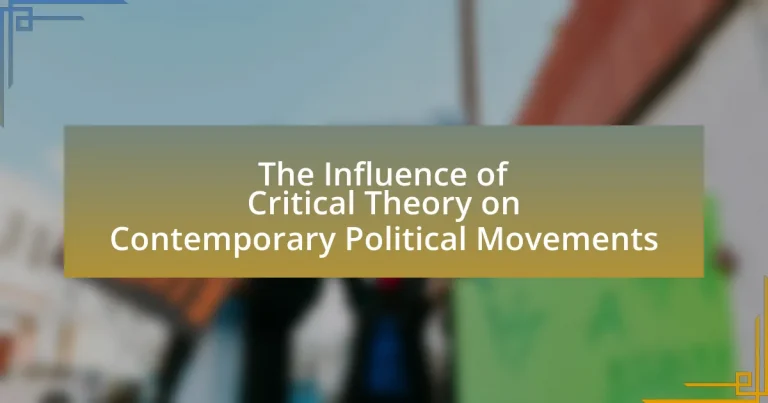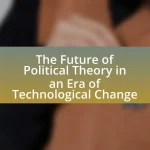Critical Theory, rooted in the Frankfurt School, serves as a significant framework for analyzing and critiquing power structures within contemporary political movements. This article explores how Critical Theory influences social justice initiatives, such as Black Lives Matter and feminist activism, by emphasizing concepts like intersectionality and systemic oppression. It examines the historical emergence of Critical Theory, its core principles, key figures, and its relevance in today’s political landscape, while also addressing the challenges and criticisms it faces. The article highlights the practical applications of Critical Theory in grassroots organizing and political activism, providing insights into effective strategies for addressing social injustices.
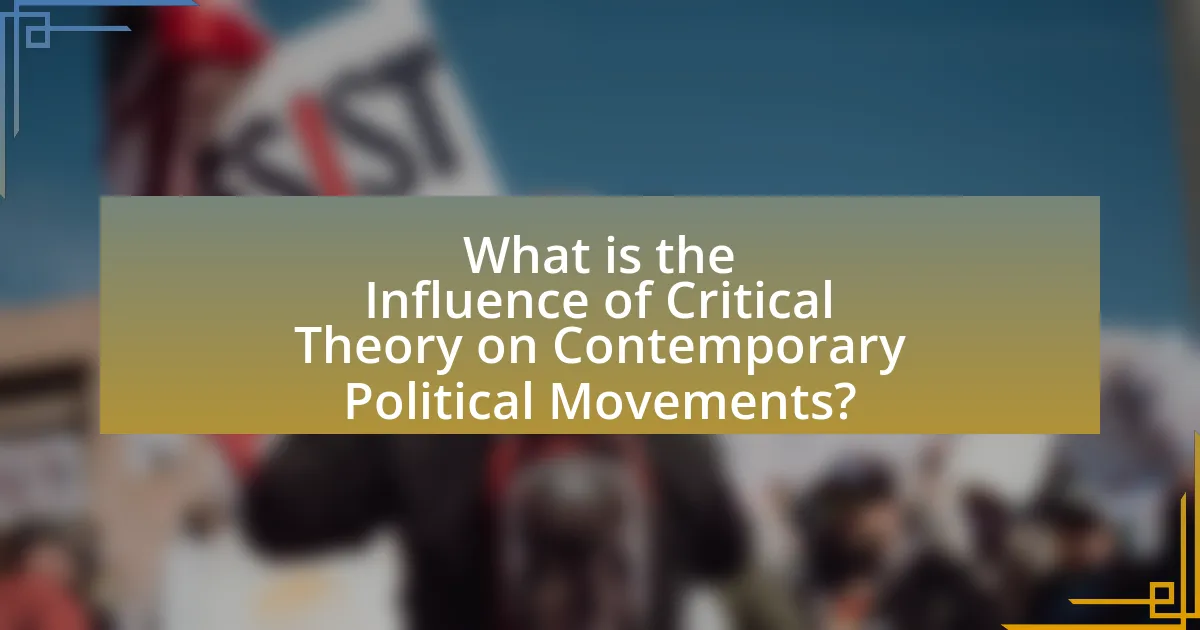
What is the Influence of Critical Theory on Contemporary Political Movements?
Critical Theory significantly influences contemporary political movements by providing a framework for critiquing power structures and advocating for social justice. This theoretical approach, rooted in the Frankfurt School, emphasizes the importance of understanding societal issues through a lens that interrogates ideology, culture, and economics. For instance, movements such as Black Lives Matter and feminist activism draw on Critical Theory to challenge systemic racism and patriarchy, respectively. These movements utilize concepts like intersectionality, which originated from Critical Theory, to highlight how various forms of oppression intersect and affect marginalized groups. The application of Critical Theory in these contexts has led to increased awareness and mobilization around issues of inequality, demonstrating its profound impact on shaping contemporary political discourse and activism.
How did Critical Theory emerge as a significant framework?
Critical Theory emerged as a significant framework in the early 20th century, primarily through the work of the Frankfurt School, which sought to address the limitations of traditional Marxism. The Frankfurt School, founded in 1923, combined Marxist analysis with other social theories, emphasizing the role of culture, ideology, and power structures in shaping society. Key figures such as Max Horkheimer, Theodor Adorno, and Herbert Marcuse contributed to this development by critiquing capitalist societies and exploring how cultural phenomena influence social change. Their interdisciplinary approach, which integrated sociology, philosophy, and psychoanalysis, established Critical Theory as a vital tool for understanding and challenging social injustices, thereby influencing contemporary political movements focused on emancipation and social transformation.
What historical contexts contributed to the development of Critical Theory?
The development of Critical Theory was significantly influenced by the socio-political upheavals of the early 20th century, particularly the rise of fascism, the aftermath of World War I, and the economic crises of the Great Depression. These contexts prompted intellectuals associated with the Frankfurt School, such as Max Horkheimer and Theodor Adorno, to critique traditional Marxism and develop a more interdisciplinary approach that incorporated insights from sociology, psychology, and philosophy. The failure of the working class to rise against capitalism during the interwar period and the emergence of totalitarian regimes highlighted the limitations of classical Marxist theory, leading to the formulation of Critical Theory as a means to understand and challenge the structures of power and domination in society.
Who are the key figures associated with Critical Theory?
Key figures associated with Critical Theory include Theodor Adorno, Max Horkheimer, Herbert Marcuse, and Jürgen Habermas. These scholars were central to the Frankfurt School, which developed Critical Theory in the early to mid-20th century. Adorno and Horkheimer co-authored “Dialectic of Enlightenment,” which critiques the Enlightenment’s role in modern society. Marcuse’s work, particularly “One-Dimensional Man,” critiques advanced industrial society and its impact on human freedom. Habermas contributed significantly with his theory of communicative action, emphasizing the role of communication in social change. Their collective contributions have profoundly influenced contemporary political movements by providing frameworks for critiquing power structures and advocating for social justice.
What are the core principles of Critical Theory?
The core principles of Critical Theory include the critique of society and culture, the emphasis on social justice, and the aim to empower marginalized groups. Critical Theory seeks to understand and challenge power structures, advocating for transformative social change. It is rooted in the Frankfurt School’s ideas, which emphasize the importance of interdisciplinary approaches, combining insights from sociology, philosophy, and cultural studies to analyze societal issues. This theoretical framework aims to reveal the underlying ideologies that perpetuate inequality and oppression, thereby fostering critical consciousness among individuals and communities.
How does Critical Theory critique traditional political ideologies?
Critical Theory critiques traditional political ideologies by emphasizing their limitations in addressing power dynamics and social injustices. Traditional ideologies often focus on maintaining the status quo, neglecting the underlying structures of oppression and inequality. For instance, Critical Theory, rooted in the Frankfurt School, argues that ideologies such as liberalism and conservatism fail to recognize how cultural and economic factors shape human experience and perpetuate domination. This critique is supported by the work of theorists like Herbert Marcuse, who highlighted how consumer culture can pacify dissent and obscure true social needs. Thus, Critical Theory seeks to unveil these hidden mechanisms of control, advocating for a more transformative approach to politics that prioritizes emancipation and social change.
What role does social justice play in Critical Theory?
Social justice is central to Critical Theory as it seeks to address and rectify systemic inequalities and injustices within society. Critical Theory, originating from the Frankfurt School, emphasizes the importance of understanding power dynamics and social structures that perpetuate oppression. By advocating for social justice, Critical Theory aims to empower marginalized groups and promote equitable social change. This focus is evident in the works of theorists like Herbert Marcuse and Theodor Adorno, who argued that social justice is essential for achieving true democracy and human emancipation. Their analyses highlight how social injustices are intertwined with cultural and economic factors, reinforcing the need for a comprehensive approach to social reform.
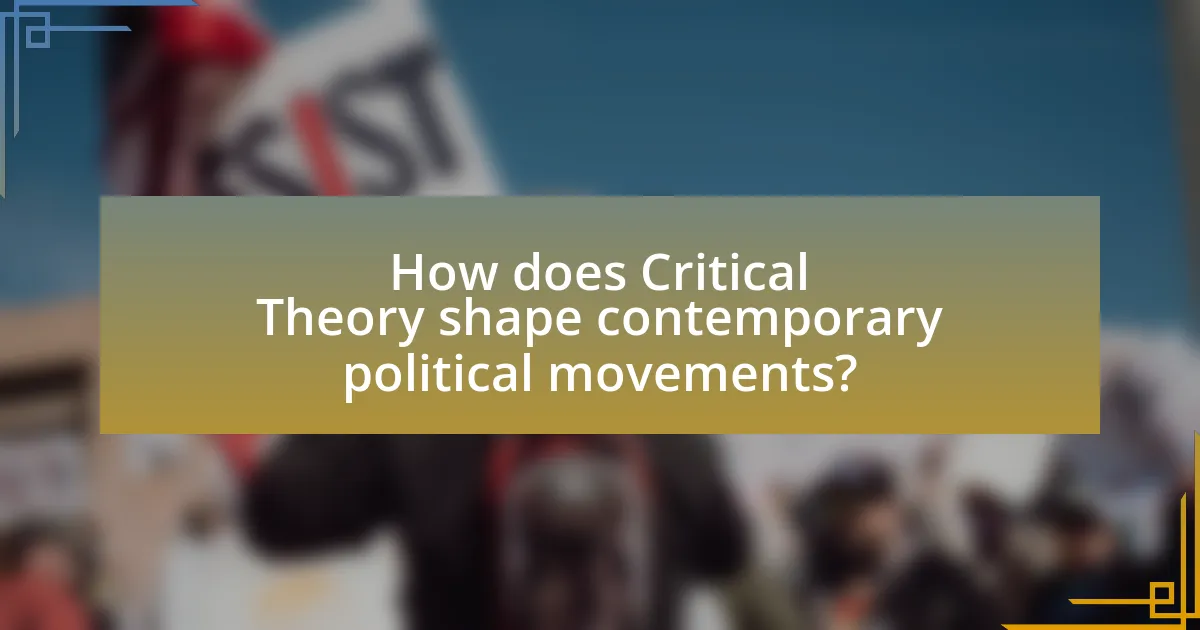
How does Critical Theory shape contemporary political movements?
Critical Theory shapes contemporary political movements by providing a framework for critiquing power structures and advocating for social justice. This theoretical approach emphasizes the importance of understanding the socio-political context and the role of ideology in perpetuating inequality. For instance, movements such as Black Lives Matter and feminist activism draw on Critical Theory to challenge systemic racism and patriarchy, respectively. These movements utilize concepts from Critical Theory, such as intersectionality and hegemony, to articulate their demands and mobilize support. The influence of Critical Theory is evident in the way these movements analyze and confront the underlying social injustices, thereby fostering a more inclusive and equitable political discourse.
What are the main political movements influenced by Critical Theory?
The main political movements influenced by Critical Theory include the Frankfurt School’s Marxist-inspired critiques, feminist movements, critical race theory, and postcolonial movements. These movements draw from Critical Theory’s emphasis on social justice, power dynamics, and the critique of societal structures. For instance, feminist movements utilize Critical Theory to analyze gender inequality and advocate for women’s rights, while critical race theory examines the intersection of race and power, challenging systemic racism. Postcolonial movements apply Critical Theory to critique colonial legacies and advocate for the rights of marginalized communities. Each of these movements reflects the foundational principles of Critical Theory, aiming to transform society by addressing issues of oppression and inequality.
How has Critical Theory impacted social justice movements?
Critical Theory has significantly influenced social justice movements by providing a framework for critiquing power structures and advocating for marginalized groups. This theoretical approach emphasizes the importance of understanding societal inequalities and the role of ideology in perpetuating oppression. For instance, scholars like Theodor Adorno and Max Horkheimer highlighted how culture and media can reinforce dominant ideologies, prompting activists to challenge these narratives. Additionally, Critical Theory’s focus on intersectionality, as developed by theorists like Kimberlé Crenshaw, has enabled social justice movements to address the complexities of identity and oppression, leading to more inclusive advocacy efforts. This theoretical foundation has been instrumental in shaping contemporary movements such as Black Lives Matter and LGBTQ+ rights, which seek to dismantle systemic injustices and promote equity.
In what ways has Critical Theory influenced environmental activism?
Critical Theory has influenced environmental activism by providing a framework for understanding the socio-political dimensions of environmental issues. This theoretical approach critiques the capitalist structures that contribute to ecological degradation, emphasizing the interconnectedness of social justice and environmental sustainability. For instance, scholars like Theodor Adorno and Max Horkheimer highlighted how consumerism and industrialization lead to environmental harm, prompting activists to advocate for systemic change rather than merely addressing surface-level ecological problems. Additionally, Critical Theory encourages a participatory approach, empowering marginalized communities to voice their concerns in environmental decision-making processes, as seen in movements like environmental justice, which emerged in the 1980s to address the disproportionate impact of environmental hazards on low-income and minority populations.
Why is Critical Theory relevant in today’s political landscape?
Critical Theory is relevant in today’s political landscape because it provides a framework for analyzing power structures and social injustices. This theoretical approach encourages critical examination of societal norms, revealing how systemic inequalities affect marginalized groups. For instance, the rise of social movements advocating for racial justice, gender equality, and environmental sustainability reflects the application of Critical Theory principles, as activists challenge dominant ideologies and seek transformative change. The ongoing discourse around issues like systemic racism and economic inequality demonstrates the practical implications of Critical Theory in shaping contemporary political agendas and mobilizing collective action.
How does Critical Theory address issues of power and oppression?
Critical Theory addresses issues of power and oppression by analyzing societal structures and cultural norms that perpetuate inequality. It critiques the ways in which dominant ideologies maintain power dynamics, often marginalizing specific groups based on race, class, gender, and sexuality. For instance, the Frankfurt School, a key proponent of Critical Theory, emphasized the role of culture in sustaining oppressive systems, arguing that mass media and education can reinforce hegemonic values that suppress dissent. This analysis is supported by empirical studies showing how systemic inequalities manifest in various social institutions, thereby validating the Critical Theory perspective on the interrelation of power and oppression.
What insights does Critical Theory provide for understanding modern protests?
Critical Theory provides insights into modern protests by emphasizing the role of power structures, social inequalities, and the importance of critical consciousness. It highlights how systemic oppression and cultural hegemony shape the motivations and actions of protest movements. For instance, Critical Theory posits that understanding the socio-political context, such as economic disparities and racial injustices, is essential for comprehending the grievances that fuel protests like Black Lives Matter and climate activism. This theoretical framework encourages activists to critically analyze their conditions and challenge dominant ideologies, thereby fostering a more profound engagement with social justice issues.
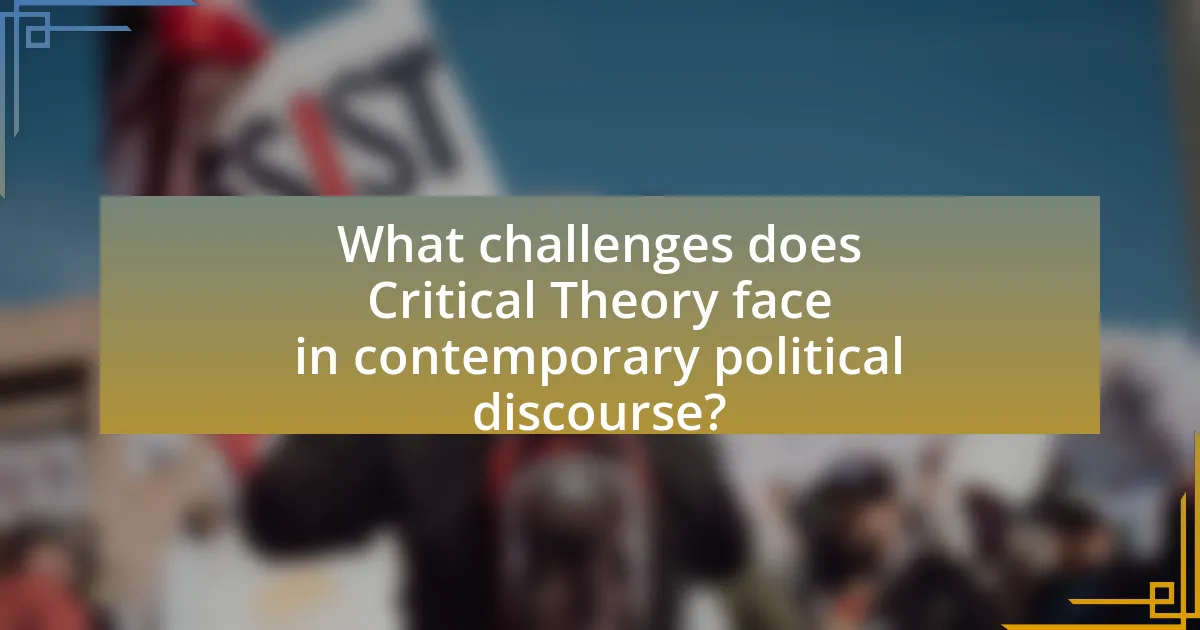
What challenges does Critical Theory face in contemporary political discourse?
Critical Theory faces significant challenges in contemporary political discourse, primarily due to its perceived elitism and complexity, which can alienate broader audiences. This complexity often leads to misunderstandings and misinterpretations of its core concepts, such as power dynamics and social justice, making it difficult for Critical Theory to engage effectively with mainstream political discussions. Additionally, the rise of populism and anti-intellectualism has created an environment where nuanced critiques of societal structures are often dismissed in favor of more simplistic narratives. These challenges hinder the ability of Critical Theory to influence political movements and public policy effectively, as its ideas struggle to gain traction in a polarized political landscape.
How do critics perceive the application of Critical Theory in politics?
Critics perceive the application of Critical Theory in politics as both a valuable analytical tool and a source of controversy. They argue that it effectively exposes power dynamics and social injustices, fostering critical awareness among marginalized groups. However, critics also contend that its emphasis on deconstruction can lead to nihilism and a lack of constructive solutions, potentially undermining political discourse. For instance, scholars like Jürgen Habermas have highlighted the risk of Critical Theory fostering division rather than unity in political movements, as it often prioritizes critique over actionable strategies. This dual perception illustrates the complex role Critical Theory plays in shaping contemporary political landscapes.
What are the main arguments against Critical Theory’s influence?
The main arguments against Critical Theory’s influence include its perceived promotion of divisiveness, its challenge to traditional values, and its reliance on subjective interpretations of social issues. Critics argue that Critical Theory fosters an “us versus them” mentality, which can exacerbate social tensions and hinder constructive dialogue. Additionally, opponents contend that it undermines established norms and institutions, leading to instability in societal structures. Furthermore, the emphasis on subjective experiences over objective truths is seen as problematic, as it can result in a lack of consensus on fundamental issues, complicating efforts for social cohesion and progress.
How do proponents of Critical Theory respond to these criticisms?
Proponents of Critical Theory respond to criticisms by emphasizing the importance of social context and power dynamics in understanding societal issues. They argue that critiques often overlook the historical and structural factors that contribute to inequality and oppression. For instance, they highlight that Critical Theory aims to reveal the underlying ideologies that perpetuate social injustices, thus providing a framework for transformative action. This perspective is supported by the work of scholars like Theodor Adorno and Max Horkheimer, who assert that traditional theories often fail to address the complexities of power relations in society. By focusing on these elements, proponents maintain that Critical Theory remains a vital tool for critiquing and challenging dominant narratives.
What practical strategies can activists use to apply Critical Theory effectively?
Activists can apply Critical Theory effectively by engaging in critical pedagogy, fostering dialogue, and utilizing intersectional analysis. Critical pedagogy encourages activists to educate themselves and others about power structures and social injustices, promoting awareness and critical thinking. Fostering dialogue involves creating spaces for open discussions that challenge dominant narratives and empower marginalized voices, which is essential for collective action. Utilizing intersectional analysis allows activists to understand how various forms of oppression intersect, enabling them to address complex social issues more comprehensively. These strategies are supported by the work of scholars like Paulo Freire, who emphasized the importance of education in social change, and Kimberlé Crenshaw, who introduced the concept of intersectionality to highlight the interconnectedness of social identities and systemic oppression.
How can Critical Theory inform grassroots organizing efforts?
Critical Theory can inform grassroots organizing efforts by providing a framework for understanding power dynamics and social injustices. This theoretical approach emphasizes the importance of critiquing societal structures that perpetuate inequality, thus enabling grassroots organizers to identify and challenge systemic barriers. For instance, Critical Theory encourages the examination of cultural narratives and ideologies that shape public perception, allowing organizers to craft messages that resonate with marginalized communities. Additionally, it promotes participatory practices that empower individuals to engage in collective action, fostering solidarity and shared goals among diverse groups. This application of Critical Theory is evident in movements such as Black Lives Matter, which utilizes critical analysis to address systemic racism and mobilize grassroots support.
What best practices should be considered when integrating Critical Theory into political activism?
Integrating Critical Theory into political activism requires a focus on intersectionality, reflexivity, and collective action. Intersectionality emphasizes understanding how various social identities (such as race, gender, and class) intersect to shape individual experiences and systemic oppression, which is crucial for creating inclusive movements. Reflexivity involves activists critically examining their own positions and biases, ensuring that their actions do not perpetuate existing power dynamics. Collective action is essential, as Critical Theory advocates for solidarity among marginalized groups to challenge dominant ideologies effectively. These practices are supported by the work of scholars like Kimberlé Crenshaw, who coined the term intersectionality, and Paulo Freire, who emphasized the importance of critical consciousness in social movements.
